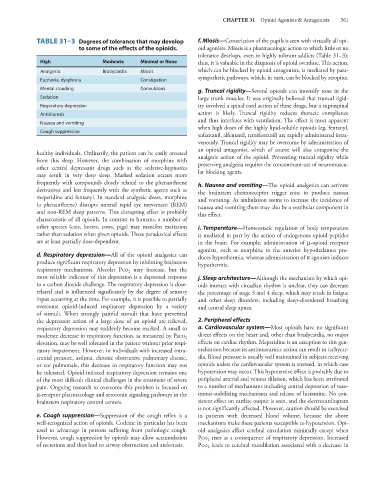Page 575 - Basic _ Clinical Pharmacology ( PDFDrive )
P. 575
CHAPTER 31 Opioid Agonists & Antagonists 561
TABLE 31–3 Degrees of tolerance that may develop f. Miosis—Constriction of the pupils is seen with virtually all opi-
to some of the effects of the opioids. oid agonists. Miosis is a pharmacologic action to which little or no
tolerance develops, even in highly tolerant addicts (Table 31–3);
High Moderate Minimal or None thus, it is valuable in the diagnosis of opioid overdose. This action,
Analgesia Bradycardia Miosis which can be blocked by opioid antagonists, is mediated by para-
Euphoria, dysphoria Constipation sympathetic pathways, which, in turn, can be blocked by atropine.
Mental clouding Convulsions g. Truncal rigidity—Several opioids can intensify tone in the
Sedation large trunk muscles. It was originally believed that truncal rigid-
Respiratory depression ity involved a spinal cord action of these drugs, but a supraspinal
Antidiuresis action is likely. Truncal rigidity reduces thoracic compliance
and thus interferes with ventilation. The effect is most apparent
Nausea and vomiting
when high doses of the highly lipid-soluble opioids (eg, fentanyl,
Cough suppression
sufentanil, alfentanil, remifentanil) are rapidly administered intra-
venously. Truncal rigidity may be overcome by administration of
an opioid antagonist, which of course will also antagonize the
healthy individuals. Ordinarily, the patient can be easily aroused analgesic action of the opioid. Preventing truncal rigidity while
from this sleep. However, the combination of morphine with preserving analgesia requires the concomitant use of neuromuscu-
other central depressant drugs such as the sedative-hypnotics lar blocking agents.
may result in very deep sleep. Marked sedation occurs more
frequently with compounds closely related to the phenanthrene h. Nausea and vomiting—The opioid analgesics can activate
derivatives and less frequently with the synthetic agents such as the brainstem chemoreceptor trigger zone to produce nausea
meperidine and fentanyl. In standard analgesic doses, morphine and vomiting. As ambulation seems to increase the incidence of
(a phenanthrene) disrupts normal rapid eye movement (REM) nausea and vomiting there may also be a vestibular component in
and non-REM sleep patterns. This disrupting effect is probably this effect.
characteristic of all opioids. In contrast to humans, a number of
other species (cats, horses, cows, pigs) may manifest excitation i. Temperature—Homeostatic regulation of body temperature
rather than sedation when given opioids. These paradoxical effects is mediated in part by the action of endogenous opioid peptides
are at least partially dose-dependent. in the brain. For example, administration of μ-opioid receptor
agonists, such as morphine to the anterior hypothalamus pro-
d. Respiratory depression—All of the opioid analgesics can duces hyperthermia, whereas administration of κ agonists induces
produce significant respiratory depression by inhibiting brainstem hypothermia.
respiratory mechanisms. Alveolar Pco may increase, but the
2
most reliable indicator of this depression is a depressed response j. Sleep architecture—Although the mechanism by which opi-
to a carbon dioxide challenge. The respiratory depression is dose- oids interact with circadian rhythm is unclear, they can decrease
related and is influenced significantly by the degree of sensory the percentage of stage 3 and 4 sleep, which may result in fatigue
input occurring at the time. For example, it is possible to partially and other sleep disorders, including sleep-disordered breathing
overcome opioid-induced respiratory depression by a variety and central sleep apnea.
of stimuli. When strongly painful stimuli that have prevented
the depressant action of a large dose of an opioid are relieved, 2. Peripheral effects
respiratory depression may suddenly become marked. A small to a. Cardiovascular system—Most opioids have no significant
moderate decrease in respiratory function, as measured by Paco direct effects on the heart and, other than bradycardia, no major
2
elevation, may be well tolerated in the patient without prior respi- effects on cardiac rhythm. Meperidine is an exception to this gen-
ratory impairment. However, in individuals with increased intra- eralization because its antimuscarinic action can result in tachycar-
cranial pressure, asthma, chronic obstructive pulmonary disease, dia. Blood pressure is usually well maintained in subjects receiving
or cor pulmonale, this decrease in respiratory function may not opioids unless the cardiovascular system is stressed, in which case
be tolerated. Opioid-induced respiratory depression remains one hypotension may occur. This hypotensive effect is probably due to
of the most difficult clinical challenges in the treatment of severe peripheral arterial and venous dilation, which has been attributed
pain. Ongoing research to overcome this problem is focused on to a number of mechanisms including central depression of vaso-
μ-receptor pharmacology and serotonin signaling pathways in the motor-stabilizing mechanisms and release of histamine. No con-
brainstem respiratory control centers. sistent effect on cardiac output is seen, and the electrocardiogram
is not significantly affected. However, caution should be exercised
e. Cough suppression—Suppression of the cough reflex is a in patients with decreased blood volume, because the above
well-recognized action of opioids. Codeine in particular has been mechanisms make these patients susceptible to hypotension. Opi-
used to advantage in persons suffering from pathologic cough. oid analgesics affect cerebral circulation minimally except when
However, cough suppression by opioids may allow accumulation Pco rises as a consequence of respiratory depression. Increased
2
of secretions and thus lead to airway obstruction and atelectasis. Pco leads to cerebral vasodilation associated with a decrease in
2

